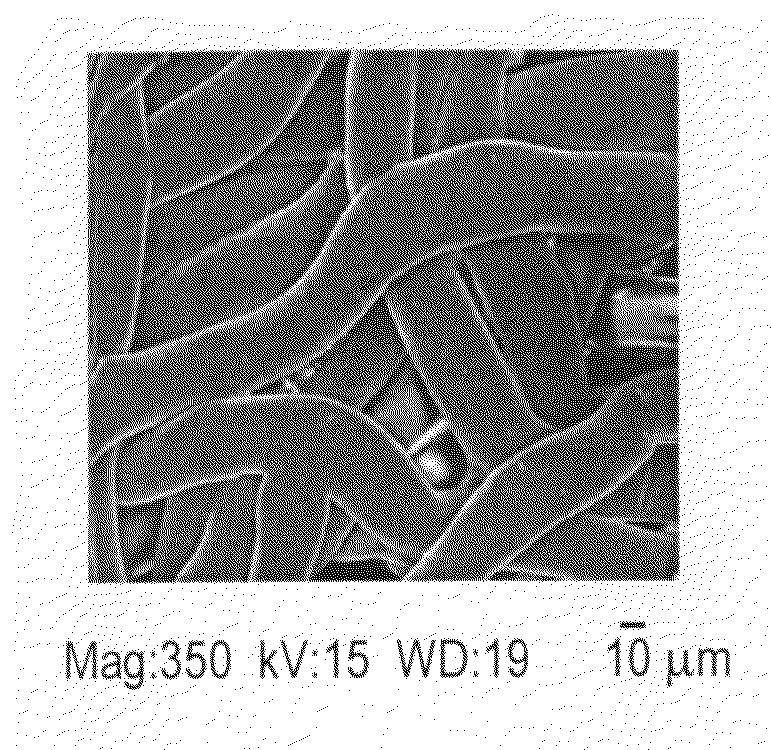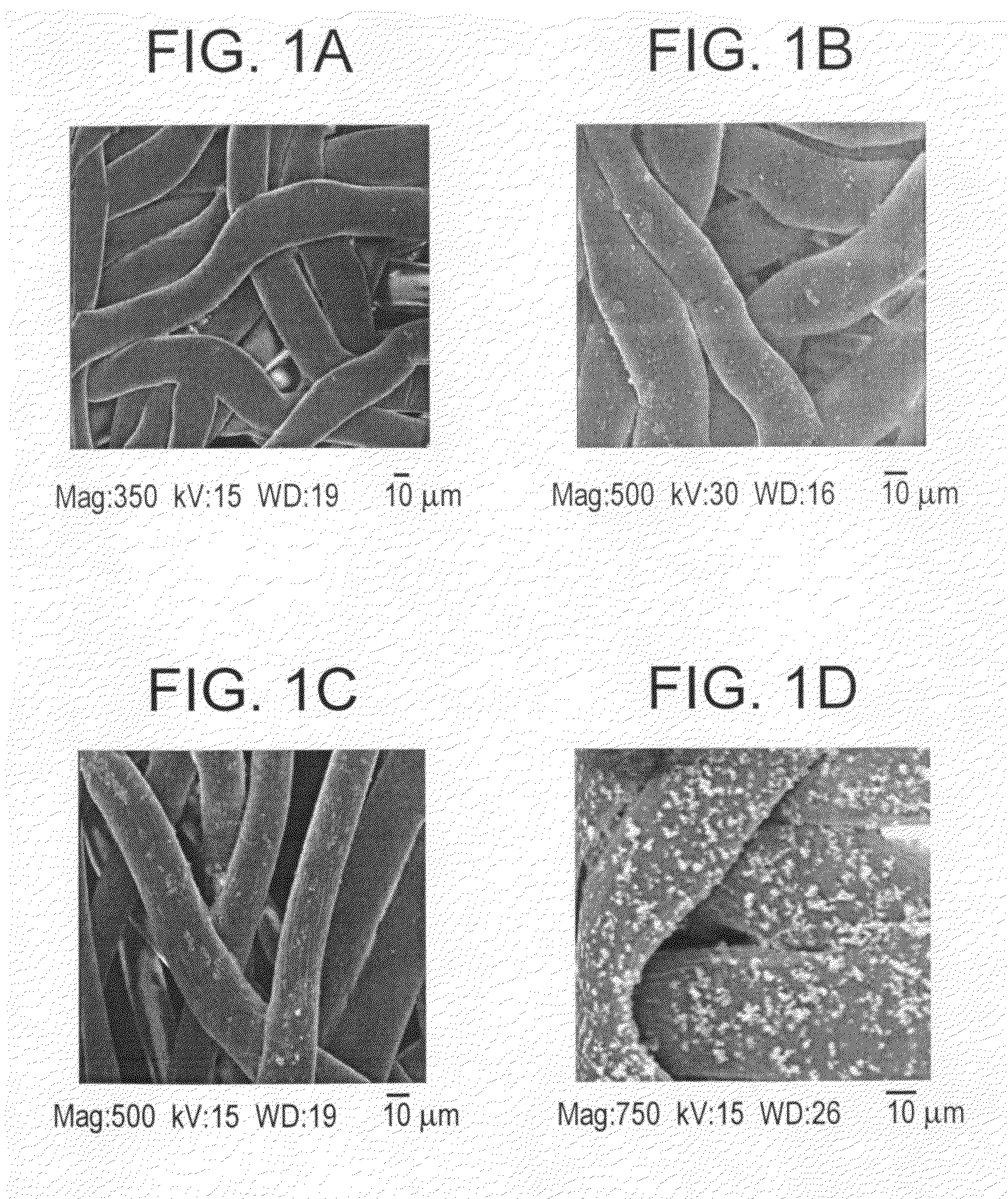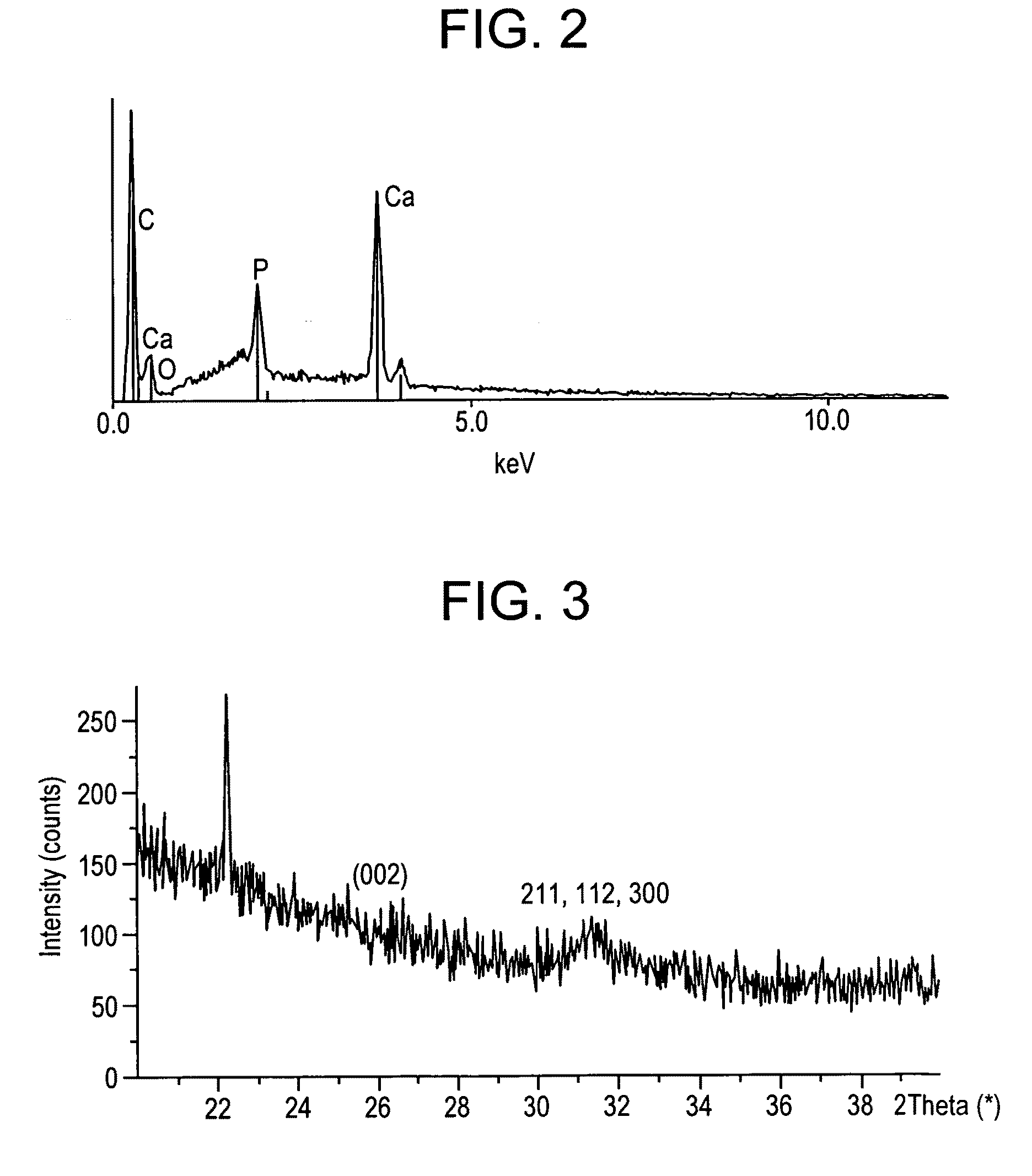[0009]The present invention features in a first aspect a method for mineralizing commercially available guided bone regeneration membranes. The method comprises the steps of (a) providing a commercially available guided bone regeneration membrane, (b) applying a mineralizing solution, and (c) exposing the membrane to microwave radiation. The method may further comprise (d) rinsing the membrane in a solution such as distilled water and (e) drying the membrane. The mineralizing solution may be a solution capable of supplying or delivering a mineral such as calcium or zinc. The microwaving step may be performed in any suitable microwave at any suitable power level and may be performed for any suitable duration, such as, for instance at least 5 minutes, at least 10 minutes, at least 12 minutes, at least 15 minutes, at least 20 minutes, etc. In some embodiments using a standard household microwave at medium power, 10-20 minutes, preferably 12-15 minutes is preferable. The mineralizing process may be performed until the mineral, such as, for instance calcium or zinc, is included in the membrane to a weight percent of at least 5%, at least 10%, at least 12%, at least 15%, at least 18%, at least 20% or at least 25% (weight percent) of the membrane. Similarly, the mineralizing process may be performed until the membrane reaches a width of at least about 1.25 times, at least 1.5 times, at least 1.67 times, at least 1.75 times or at least two times or even at least three times its original width as determined immediately before the mineralizing process was begun. The method of mineralizing as described herein comprising the step of exposing the membrane to microwave radiation is applicable to other medical and dental devices or materials including, but not limited to dental and orthopeadic implants, surface treatments, etc. and the method may be applied to modify existing bone grafting materials as one of ordinary skill in the art will readily understand.
[0010]In a second aspect, the invention provides a mineralized commercially available guided bone regeneration membrane. The mineralized guided bone regeneration membrane may be resorbable such as, for instance, poly-lactic acid (PLA), polylactic-glycolic acid (PLGA) or collagen or non-resorbable such as, for instance, e-PTFE or teflon. Similarly, the guided bone regeneration membrane may comprise natural polymers such as collagen or silk fibroin, or the guided bone regeneration membrane may comprise synthetic polymers such as, for instance, a polymer selected from the group consisting of PLA and PLGA, PFTE, and caprolactone. The mineralized guided bone regeneration membrane may be made by the method set forth, supra, comprising the steps of (a) providing a commercially available guided bone regeneration membrane, (b) applying a mineralizing solution, and (c) exposing the membrane to microwave radiation. The guided bone regeneration membrane may comprise a mineral, such as, for instance calcium or zinc at a weight percent of at least 5%, at least 10%, at least 12%, at least 15%, at least 18%, at least 20% or at least 25% (weight percent of the membrane). Naturally, more than one mineral may be present, including but not limited to calcium and / or zinc and / or phosphate and / or fluoride, and in the case where more than one mineral is present, the total weight percentages may equal those set forth, supra, or they may be additive to a total of, for instance, at least 5%, at least 10%, at least 12%, at least 15%, at least 18%, at least 20%, at least 25%, at least 30%, at least 40% or at least 50% (weight percent of the membrane). Additional ions or minerals, such as, for example, magnesium may be present in some embodiments. Similarly, the guided bone regeneration membrane, once mineralized, may have a width of at least about 1.25 times, at least 1.5 times, at least 1.67 times, at least 1.75 times or at least two times or even at least three times its original width as determined immediately before the mineralizing process was begun. The guided bone regeneration membrane may be biologically active to allow attachment, proliferation, migration and phenotypic expression of bone cells and be useful in leading to formation of new bone. Hence, the guided bone regeneration membrane may have applications in, for instance, dentistry and orthopedics. Also, in some embodiments, the guided bone regeneration membrane may be biologically active to promote increased collagen production. Similarly, in other embodiments, the guided bone regeneration membrane may be biologically active to inhibit bacterial colonization or bacterial infection. The guided bone regeneration membrane may be only one membrane layer thick, or it may be two, three, four or more membrane layers thick. That is, more than one individual membrane may be added to form the guided bone regeneration membrane according to the invention. In such embodiments where more than one membrane layer is provided, only one, two or even all individual membrane layers may be mineralized.
[0011]In a third aspect, the present invention provides a method for promoting or enhancing bone regeneration comprising providing a mineralized guided bone regeneration membrane. The guided bone regeneration membrane may comprise a mineral such as calcium or zinc. In preferred embodiments, the mineral, such as, for instance calcium or zinc or phosphate, is present in the membrane to a weight percent of at least 5%, at least 10%, at least 12%, at least 15%, at least 18%, at least 20% or at least 25% (weight percent) of the membrane. In some embodiments, additional minerals, such as, for instance, fluoride or magnesium may be present. Similarly, in some preferred embodiments, the membrane has a width of at least about 1.25 times, at least 1.5 times, at least 1.67 times, at least 1.75 times or at least two times or even at least three times its original width as determined immediately before the membrane was mineralized. In especially preferred embodiments, the membrane is one described, supra, in the second aspect of the invention, and it may be made according to the method set forth, supra, in the first aspect of the invention comprising the steps of (a) providing a commercially available guided bone regeneration membrane, (b) applying a mineralizing solution, and (c) exposing the membrane to microwave radiation. The method may be characterized by the presence of osteoblasts adhered to the membrane, and it may be characterized by increased production of collagen relative to methods using a guided bone regeneration membrane that has not been mineralized or that has not been mineralized by the method set forth, supra, according to the first aspect of the invention. In preferred embodiments, the bone regeneration is of a bone or bones in or near the oral cavity. However, in other embodiments any bone for which regeneration is sought may be the subject bone. In some embodiments, only one layer of membrane is used, however, in other embodiments multiple layers may be provided. In some embodiments, one of the multiple layers of membranes may comprise a membrane comprising one mineral according to the invention while another of the multiple layers may comprise a membrane having a second mineral according to the invention. In some embodiments, this aspect of the invention is accomplished by providing a mineralized guided bone regeneration membrane having one mineralized layer or one mineralized side. In such embodiments, the mineralized layer or the mineralized side is provided to face a bone defect.
[0012]In a fourth aspect, the present invention provides a method for inhibiting bacterial colonization or a method for inhibiting bacterial infection or a method for reducing inflammation comprising providing a mineralized guided bone regeneration membrane. The guided bone regeneration membrane may comprise a mineral such as calcium or zinc. In preferred embodiments, the mineral, such as, for instance calcium or zinc or phosphate, is present in the membrane to a weight percent of at least 5%, at least 10%, at least 12%, at least 15%, at least 18%, at least 20% or at least 25% (weight percent) of the membrane. In some embodiments, additional minerals, such as, for instance, fluoride or magnesium may be present. Similarly, in some preferred embodiments, the membrane has a width of at least about 1.25 times, at least 1.5 times, at least 1.67 times, at least 1.75 times or at least two times or even at least three times its original width as determined immediately before the membrane was mineralized. In especially preferred embodiments, the membrane is one described, supra, in the second aspect of the invention, and it may be made according to the method set forth, supra, in the first aspect of the invention comprising the steps of (a) providing a commercially available guided bone regeneration membrane, (b) applying a mineralizing solution, and (c) exposing the membrane to microwave radiation. The method may be characterized by the presence of osteoblasts adhered to the membrane, and it may be characterized by increased production of collagen relative to methods using a guided bone regeneration membrane that has not been mineralized or that has not been mineralized by the method set forth, supra, according to the first aspect of the invention. In preferred embodiments, the bone regeneration is of a bone or bones in or near the oral cavity. However, in other embodiments any bone for which regeneration is sought may be the subject bone. In some embodiments, only one layer of membrane is used, however, in other embodiments multiple layers may be provided. In some embodiments, one of the multiple layers of membranes may comprise a membrane comprising one mineral according to the invention while another of the multiple layers may comprise a membrane having a second mineral according to the invention.
 Login to View More
Login to View More 


